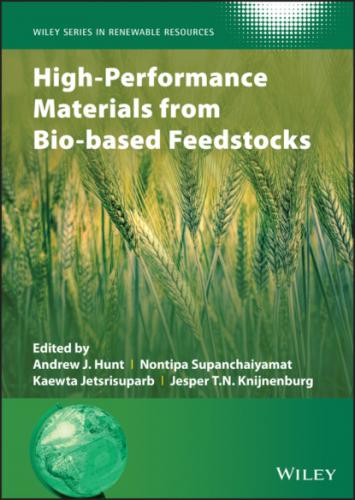In other words, the adsorption behaviour is strongly linked both to micropore adsorption and to a combination of micropores and mesopores, suggesting that the combination of mesopores and micropores allows excellent transport to the adsorption sites as well as some mesopore adsorption.
Very importantly, CO2 to nitrogen selectivity was measured for Norit, S800 and A800 using mixed gas streams at 298 and 323 K. What was striking here was that selectivity to CO2 was much higher for the Starbon materials (14.0–20.3) than for Norit (5.4 at 298 K and 4.0 at 323 K) meaning that adsorption in real situations would benefit from the use of the Starbon materials.
3.2.4.2 Adsorption or Organics from Solution
Parker et al. [36] demonstrated that Starbon materials have a very impressive ability to adsorb a range of small phenolic molecules from water. They chose the relatively hydrophobic and low oxygen content Starbon‐800 materials as their adsorbents, and compared starch‐derived systems with alginic‐acid‐derived systems. Both materials exhibited equally good adsorbency behaviour over a range of phenols in an aqueous solution (Table 3.4). The starch‐derived S800 had around twice the surface area of the alginate A800, but much of the ‘extra’ surface area was present as micropores and ultramicropores, which likely contribute less to the adsorption behaviour. It is tempting to think that the process is therefore as simple as being directly related to a similar mesopore surface area; however, a more detailed analysis of the relevant adsorption isotherms indicated that somewhat more complexity is involved.
Table 3.4 Collected data for the adsorption of phenols on alginic‐acid‐derived Starbon (A) and on starch‐derived Starbon (S).
Source: Data from Parker et al. [36].
| Phenol | ΔG (kJ mol−1) | ΔH (kJ mol−1) | ΔS (J mol−1K−1) | Qo (mg g−1) | n | |||||
|---|---|---|---|---|---|---|---|---|---|---|
| A | S | A | S | A | S | A | S | A | S | |
| H‐ | −0.13 | −0.91 | 1.7 | −3.8 | 6.0 | −9.7 | 40.3 | 100 | 0.03 | 5.7 |
| 2‐Me | −2.8 | −1.6 | −16 | 4.2 | −4.3 | 20 | 0.08 | 94.6 | 3.6 | 5.8 |
| 2‐F | −2.0 | −2.5 | −11 | −4.1 | −32 | −5.4 | 206 | 131.8 | 0.01 | 6 |
| 3‐NH2 | −0.42 | −0.57 | 8.9 | −1.8 | 32 | −4.0 | 241 | 101.2 | 0.01 | 6.6 |
| 4‐OMe | −1.2 | −2.8 | 37 | −4.9 | 128 | −6.9 | 146 | 118.6 | 3.8 | 14.1 |
First, using Langmuir and Freundlich isotherms, it was postulated that the surfaces have significant heterogeneity, with some residual oxygen functionality being responsible for the heterogeneous surface energy. Physisorption was also indicated by the isotherms (via heterogeneity factor and adsorption energy values). Perhaps, unsurprisingly, for systems where mesoporosity is important, multilayer adsorption is evident, with all systems going well beyond surface coverage. What is surprising is that, despite the similar capacities of the two materials, the monolayer adsorption capacities are similar for all phenols for S800, but vary significantly for the same molecules in the case of A800. Similarly, the thermodynamic parameters for the adsorption of S800 and A800 are very different, suggesting a quite different mode of adsorption within the group of phenolics, with some being entropy‐driven (approximating to release of waters of hydration at the surface/around the phenol) and others enthalpic (stabilising interactions between surface and adsorbate). A positive contribution to the adsorption via entropy seems more prevalent in the alginic acid series of adsorbents.
The same group, in collaboration with a group at Menoufia University in Egypt, also examined the potential of Starbon materials in decontaminating grey water from laundrettes. This is the post‐wash waters that are expelled from washing machines and which are contaminated with suspended solids, minerals such as potassium and phosphate, as well as detergent molecules and aggregates. Re‐use of the very substantial quantities of grey water would go a long way to reducing the water requirements of large conurbations.
The first paper [37] focused on a combination of Fentons reagent (Fe(III) and hydrogen peroxide) with Starbon‐300 to clean up grey water by a combination of oxidation and adsorption. Chemical oxygen demand (COD) reduction was used as a determinant of success. A series of operating parameters were investigated for each of the two components separately, and then the optimum combination of the two was investigated. For the Fenton’s reagent and hydrogen peroxide system, optimal iron and hydrogen peroxide concentrations were determined beyond which efficiency dropped significantly. The influence of pH was also investigated, and a definite trend was seen with lower pH values giving significantly better results. This is attributed to the role of pH in guiding the relatively complex Fenton’s chemistry to the highest production of hydroxyl radicals, the most active species. For adsorption on Starbon, similarly acidic conditions were optimal for adsorption of materials and reduction in COD.
A separate series of experiments using dual treatment (Fentons reagent and Starbon together)
